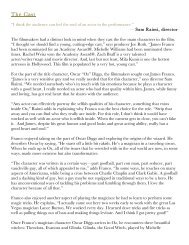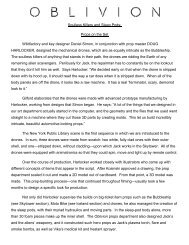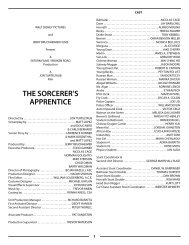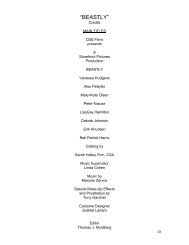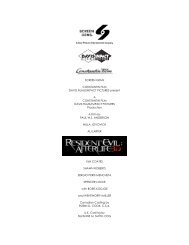THE INFECTED CAST - CHICAGO SCI-FI
THE INFECTED CAST - CHICAGO SCI-FI
THE INFECTED CAST - CHICAGO SCI-FI
You also want an ePaper? Increase the reach of your titles
YUMPU automatically turns print PDFs into web optimized ePapers that Google loves.
<strong>THE</strong> <strong>INFECTED</strong> <strong>CAST</strong><br />
Of course, the most critical part of the film is the zombies themselves. Forster and company wanted to<br />
honor the genre but not be beholden to it, to create something original and organic to this particular story.<br />
“With zombie movies, ultimately, everyone goes back to George Romero’s because they are so iconic.<br />
More recently, there was ‘28 Days Later’ and so on. So, as a filmmaker, you always try to do something new<br />
and different even though you are working within the framework of its history. And that’s what we tried to do<br />
with this. There are certain classic zombie elements that we brought along, but their movements and<br />
motivations will be different,” Forster says.<br />
Specifically, filmmakers based their behavior on the “swarm theory,” a pattern of movement seen in<br />
nature that he underscored even before these quite unnatural creatures appeared on screen.<br />
“It’s the way flocks of birds or fish or ants move together. There is almost a ‘swarm intelligence’ to it. I<br />
thought it would be interesting to see these zombies, who have no intellect since they are walking dead, react in<br />
this swarm mentality. There is not a real direction because the zombies are the undead. But as a whole, there is<br />
an unconscious consciousness.<br />
When they are moving at this hysterical pitch, the zombies are their most dangerous – however they are<br />
not always aggressive. In ‘World War Z,’ the best but still horrific glimpses we have at the zombies are when<br />
they are dormant.<br />
“When they are not provoked, they are stagnant, slow and wandering. When the feeding frenzy starts,<br />
it’s almost like a shark that smells blood. In the moment they sense that there's something to attack, they will<br />
just go for it. And that we establish very early, that they're drawn by sound,” Forster says.<br />
The filmmakers deliberately and conscientiously created a credible “backstory” for zombie behavior; to<br />
do so, like Gerry, they began with their origins.<br />
“A lot of work went into citing our zombie mythology in science. We hired a few different consultants<br />
who talked about everything from infectious disease to hive behavior to physiological defense mechanisms.<br />
How people or animals protect themselves in the face of a parasite, for example, and how do they survive that.<br />
It seemed much more interesting to us to root our zombies as much in fact as possible, knowing full well that<br />
they are not real. And then the second phase was figuring out how to express that. Once you get into that cluster<br />
of thought, a whole bunch of other doors open. There’s the zombie that has just turned – what the does the turn
itself actually look like? How long does it take? How fast do they then turn on someone else? Do they need to<br />
be provoked to do so? What are the conditions that would provoke them? What does a zombie look like that’s<br />
been a zombie for an hour vs. one that’s been a zombie for a month? Then there’s obviously the question of<br />
speed. Zombies are historically slow. But we wanted both slow and fast zombies because different<br />
environmental circumstances in our film allowed for it,” Gardner says.<br />
To create the zombie legion, the team turned to a combination of effects and artists – dancers, stunt<br />
people, prosthetics, make-up, CGI and carefully choreographed camera moves. And not every zombie was the<br />
same from scene to scene; each had their own specific dance, as designed by choreographer Alexandra<br />
Reynolds. The first human we see succumb to the zombie infection is played by movement specialist Ryen<br />
Perkins-Gangnes.<br />
“I studied how people start to move when they have epileptic seizures and we based the change from<br />
human to zombie on that. Ryan is an incredible movement artist and was very good at conveying that<br />
contortionist movement, that literally was all him. I mean we added veins popping and we see his eyes change<br />
with CGI. The eyes were very important to me – I thought once the eyes change, the person really is the<br />
walking dead,” Forster says.<br />
The future zombies began to learn their dance at workshops in pre-production where they drew on many<br />
influences, from insects to police attack dogs to Javier Bardem’s performance in ‘No Country for Old Men.”<br />
“We started by trying to find out the zombies’ state of mind so we thought of movies that perhaps had a<br />
character without any humanity. We thought that Javier Bardem’s character in ‘No Country for Old Men’ had<br />
an interesting feel about it. So we spent a lot of time trying to recreate what it might feel like to be him, so the<br />
movement came from within. Alex also brought in many different images of insects feeding, how rapacious and<br />
relentless they are and their pace which can go from really fast to slow and rhythmical and really fast again.<br />
Also she brought in videos of Israeli police dogs, the way they latch on with their jaws and their bodies would<br />
flail and their spines would be twisting all over the place. So we became this sort of insect-y, jaw-driven<br />
creature devoid of any humanity or sense of future or past, just stuck in the present moment,” Perkins-Gangnes<br />
explains.<br />
Alexandra Reynolds also worked with animation director Andy Jones and her “troupe” of zombies to<br />
explore and refine their motion. She did extensive and eclectic research to choreograph their gruesome dance.<br />
“The script had such incredible imagery that truly resonated with me. I wanted to have an effect that was<br />
visceral and real and would absolutely stay with the hero and the audience. I looked at some Victorian medical<br />
journals. I examined how the body can go into shock and paralysis. All the time we were looking for something<br />
that we could no longer recognize as human but could stay in the realm of what was possible. I didn’t want to<br />
go into fantasyland; I wanted it to be much darker than that. Marc’s aspiration was that the zombies are unique<br />
and different and he asked me to improvise and experiment to find that new language,” she explains.
each zombie.<br />
Costume designer Mayes Rubeo also contributed to this “new language,” with the idiosyncratic look of<br />
“We wanted to show the process from human to zombie through the costumes. Not everyone has the<br />
same bite, not everybody is hurt or traumatized in the same way. If you look at every zombie we have, every<br />
one of them has a specific design, including the aging of the wardrobe, the condition of the clothes, the amount<br />
of blood. We wanted to portray each one as an individual in a certain stage of the epidemic. This all came from<br />
our director Marc Forster, at the helm of this zombie operation,” Rubeo explains.<br />
All this attention to detail was often horrifyingly revealed in giant sweeping shots, including a terrifying<br />
reveal of zombies climbing on top of each other to scale an “impregnable” wall. Often, Forster turned to these<br />
sweeping shots and eschewed the quick cuts and shaky frame.<br />
“Certain movies lend themselves to a more frenetic camera and editorial style. In this one, we chose to<br />
have more stable camera moves. The idea of having thousands of zombies trying to get over a wall as<br />
helicopters shoot at them, I think those sequences have been extremely well executed,” Ian Bryce says.<br />
bullets.<br />
In fact, in addition to traditional crane moves, actual choppers did shoot those zombies, albeit not with<br />
“We did a lot of helicopter shots in Malta,” Bryce says. “Sometimes you just have to get in the<br />
helicopter to capture the scope of the set.”



